Chapter: 11th Microbiology : Chapter 1 : Introduction to Microbiology
Contributors to Microbiology
Contributors to Microbiology
Many scientists contributed to the
science of Microbiology from the 17th century to the present day.
Some prominent microbiologists who have made significant contribution to the
study of microorganisms are given below:
Antony Van Leeuwenhoek
Antony Van Leeuwenhoek (1632-1723) of
Holland (Figure 1.1) developed microscopes. He was a Dutch merchant and a
skilled lens maker. He made a variety of lenses with magnifying power 50-300X.
He was the first person to invent
simple microscope. It has a single biconvex lens with a magnification of about
200X (Figure 1.2). His microscopes resolved bodies with diameters measuring
below 1micron. He examined water, mud, saliva and found living organisms. He
called these microorganisms as Animalcules (little animals). Bacteria like cocci, bacilli and spirochetes
were recognized. He proposed that the size of bacteria is one sixth the
diameter of Red Blood Cells.
He observed the growth of bacteria in
infusions. The existence of spermatozoa and RBC was revealed by him. Animal
histology was established by him. He described capillary circulation and added
a new dimension to Biology. All kinds of unicellular microorganisms were
accurately described by him including human oral microbial flora. He is
commonly known as the ‘Father of Microbiology’.
Louis Pasteur (1822-1895)
Louis Pasteur was a French chemist
and a crystallographer (Figure 1.3). His greatest contribution to microbiology
made him to be the ‘Father of Modern Microbiology’.
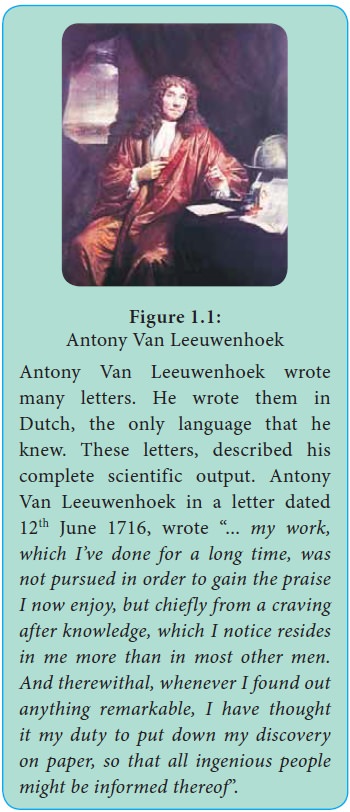
Contribution to science as a chemist
Louis Pasteur was working with tartaric acid crystals. He could pick up the dextro and levo rotatory crystals by seeing the morphology of the crystals. Later he was called to solve some of the problems in fermentation industry and turned his attention to biological process of fermentation.
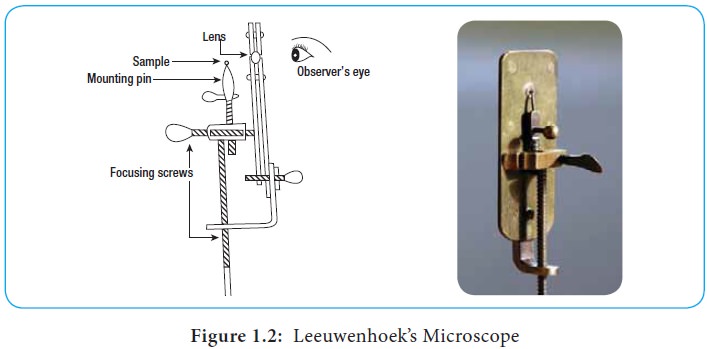
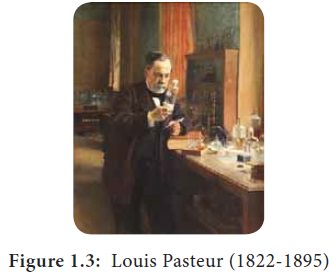
Contribution to Microbiology
To wine industry
Louis Pasteur discovered alcohol
production from grape juice was due to yeast. The presence or contamination of
rod shaped bacteria resulted in large amounts of lactic acid production in
wine. He also found that microorganisms in fermented fruits and grains,
resulting in alcohol production. He coined the term “fermentation”.
Pasteur disproved spontaneous
generation Spontaneous generation states that
life could arisespontaneouslyfrominanimate(non-living) materials (Abiogenesis).
Pasteur disproved the theory of spontaneous generation. He strongly supported
theory of Biogenesis (life orginates from pre-existing life forms). To prove
this he carried out several experiments. Pasteur poured meat infusions into
flasks and then drew the top of each flask into a long curved neck that would
admit air but not dust (Figure 1.4). He found that if the infusions were
heated, they remained sterile (free from any growth) until they were exposed to
dust. After opening them on a dusty road and resealing them, he demonstrated
the growth of microorganisms in all the flasks. The unopened flasks were
sterile. Thus he disproved the theory of spontaneous generation.
Pasteurization
Louis Pasteur used heat to destroy
undesirable microbes in fruit juices. He employed 62.8°C (145°F) for 30 mins to
kill microbes. This process is called Pasteurization which is commonly used in
distillaries and dairy industry.
Discovery of diseases
Louis Pasteur found that Pebrine
disease in silk worm was caused by a protozoan parasite. He suggested that
Pebrine disease could be eliminated by using only healthy, disease free silk
worms. Wool Sorter’s disease was named as “Anthrax” by him. He isolated Bacillus anthracis from the blood of
infected animals. Chicken cholera
bacterium was also isolated by Louis Pasteur using pure culture.
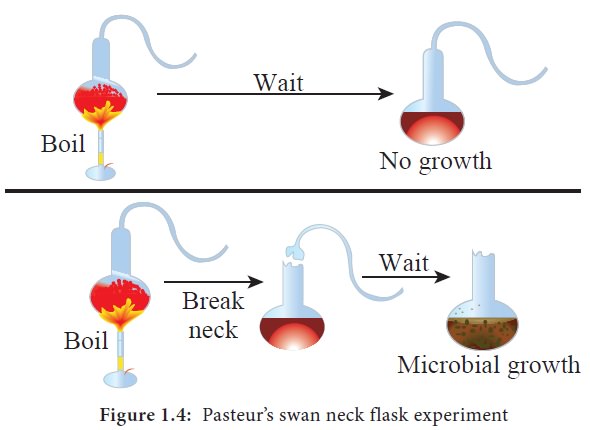
He proved that many diseases were
caused by the presence of foreign microorganisms (Germ theory of disease). He discovered various infection causing microorganisms such as Staphylococcus, Streptococcus and Pneumococcus.
Vaccination
Pasteur found out that bacteria could
be attenuated by growing them in unnatural conditions. He coined the term “attenuation”. It is a process wherein bacteria lose their virulence due to
repeated subculturing under laboratory conditions. He used attenuated cultures
as vaccines for immunizing and protecting an individual against the disease. He
developed vaccines for anthrax and rabies.
Edward Jenner (1749-1823)
In ancient observation, persons who
had suffered from a specific disease such as small pox (causative agent of
small pox is varicella virus) or mumps, resisted the infection on subsequent
exposures. They rarely contracted these infections for second time. Edward
Jenner, a country doctor in England noted a pustular disease on the hooves of
horses called the grease. This was carried by farm workers to the nipples of
cows (cow pox). This was again carried by milk maids. They got inflamed spots
on the hands and wrists. The people who got this cow pox were protected from
small pox. He reported that 16 farm workers who had recovered from cow pox
(causative agent of cow pox is vaccinia virus) were resistant to small pox
infection.
He took the material (pus) from the
cow pox and inoculated into the cut of 8 year old boy on 14th May
1796 (Figure 1.5). Two months later Jenner inoculated the same boy with
material taken from small pox patients. This was a dangerous but accepted
procedure at that time. This procedure was called variolation. The boy was
protected against small pox. His exposure to the mild cow pox disease had made
him immune to the small pox disease. In this manner Jenner began the Science of
Immunology, the study of the body’s response to foreign substances. Edward
Jenner was regarded as the ‘Father of Immunology’.
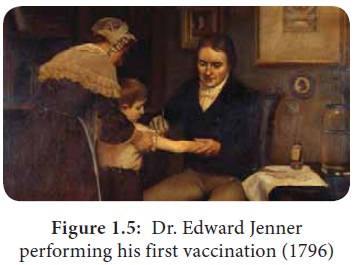
Robert Koch (1843-1910)
Robert Koch was a German physician
and microbiologist (Figure 1.6). He was the founder of Modern Bacteriology.
Robert Koch discovered Bacillus anthracis
(Anthrax bacillus), Mycobacterium
tuberculosis, and
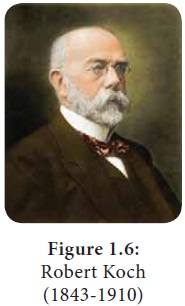
For the first
time he showed the evidence that a
specific germ (Anthrax bacillus) was the cause of a specific disease (splenic
fever in sheep) and introduced scientific approach in Microbiology.
He modified Ziehl-Neelsen Acid Fast
staining procedure which was introduced by Ehrlich. He devised solid medium to
grow microorganism. He developed powerful method to isolate the microorganisms
in pure culture from diseased tissue. He also perfected the techniques of
identification of the isolated bacteria.
He introduced Koch’s thread method to find out the efficacy of disinfectants. He established certain rules that must be followed to establish a cause and effect relationship between a microorganism and a disease. They are known as Koch’s Postulates. He also described the Koch’s Phenomenon. He was regarded as the ‘Father of Medical Microbiology’.
Koch’s Postulates
Four criteria were established by
Robert Koch to identify the causative agents of an infectious disease. These include
1. A specific organisms can always be
found in association with a given disease. If we take typhoid as an example it
is caused by a bacterium Salmonella
typhi.
2. The organism can be isolated and
grown in pure culture in the laboratory. Salmonella
typhi are grown in soild media
under laboratory conditions.
3. The pure culture will produce the diseases when inoculated into a susceptible animal.
Almost all the pathogenic organisms produce the same disease in experimental animals. Usually rats, mice, rabbits or guinea pigs are used as experimental animals. Pneumococci produce pneumonia in animals. Salmonella species do not produce typhoid fever in rat, mice or rabbit. So chimpanzee is taken as experimental animal and it produces fever in chimpanzee.
4. It is possible to recover the
organism in pure culture from the experimentally infected animals and it is
observed to be the same as originally inoculated pathogen. Figure 1.7 explains
the Koch’s postulates.
Limitations
Some organisms have not yet been
grown in artificial culture media
Example: Mycobacterium leprae and Treponema
pallidum.
Modern addition to Koch’s Postulates
Today we recognize additional
criteria of causal relation between a microorganism and a disease. The important
one is the demonstration of abnormally high concentration of specific
circulating antibodies to the organism in the infected host or the presence of
abnormally high degree of specific immunity or hypersensitivity to the
infecting agent in a recently recovered host. In addition to culture
techniques, serological techniques are also used for diagnosis of diseases.
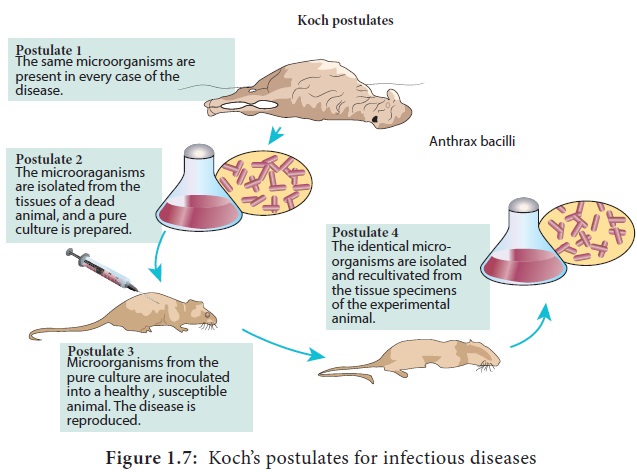
Usefulness of Koch’s Postulates
·
It is useful in determining
pathogenic organisms.
·
To differentiate the pathogenic and
nonpathogenic microorganism.
·
For the classification of organisms.
·
To detect the susceptibility or
resistance of the laboratory animals.
Joseph Lister(1827-1912)
Joseph Lister was a British surgeon
(Figure 1.8). He found out that microorganisms were responsible for wound
infections. He developed s system of antiseptic surgery. He used bandages
Joseph Lister soaked in phenol (1827-1912) solution to prevent wound infection. He sterilized instruments by heat
and sprayed diluted phenol over surgical area and prevented contamination of
wounds. He was the first person to isolate bacteria in pure culture using
liquid culture. Thus, he was considered as co-founder of Medical Microbiology
with Koch, who later isolated bacteria on solid media.
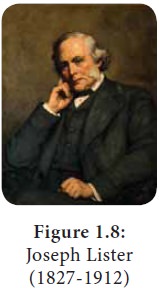
Alexander Fleming (1881-1955)
He was a British Bacteriologist. He
observed a mold (Penicillium notatum)
growing on a plate of Staphylococcus aureus. The growth of Staphylococcus aureus around the mold
colony was
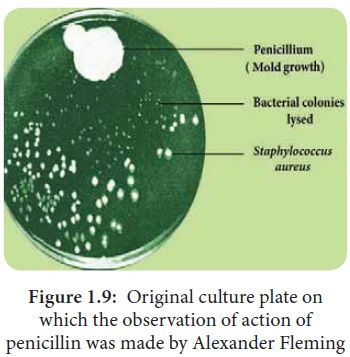
He also
showed that the culture filtrate of mold inhibited the growth of Staphylococcus aureus. He called this
substance Penicillin, which acted on Gram positive bacteria. For the discovery
of this antibiotic Fleming (Figure 1.10), Florey and Chain got Nobel Prize in
1945. Penicillin eventually came into use during world war II as a result of
the work of a team of scientists led by Howard Florey of the University of
Oxford.
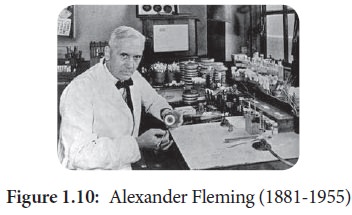
Selman Abraham Waksman (1888-1973)
Waksman was from Rutger University,
USA (Figure 1.11). His research was largely on soil microorganisms. He showed
antimicrobial activity of streptomyces that led to the discovery of
Streptomycin and several other antibiotics.
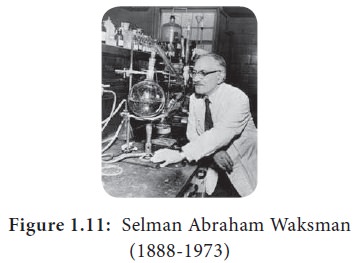
Waksman and his co-workers isolated
Actinomycin in 1940, Streptothrecin in 1942, Streptomycin in 1943, and Neomycin
in 1949.
Streptomycin is produced by Streptomyces
griseus. It is a secondary metabolite produced by Streptomyces griseus which is not required for its growth but may help it to compete with
other bacteria for food and space in the environment. Streptomycin is used in
the treatment of tuberculosis. Waksman got Nobel Prize in 1952. for his work on
Streptomycin
Related Topics